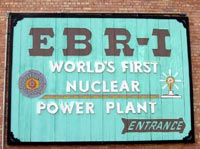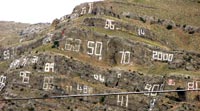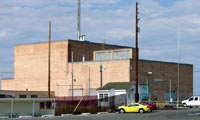Getting
Out There: |
Directory of all "Getting Out There" Articles> |
Touring the World's First Nuclear Power Plant
by Mark Sedenquist
|
Just slightly to the north of the old track of the Oregon Trail and to the west of Idaho Falls lies Butte County, Idaho. Butte County is home to a number of scenic spots including Craters of the Moon National Monument, King Mountain (famous for hang-gliding), and the impressive display of rock graffiti just outside of Arco, where scores of high school students have emblazoned the mountainside with the year of their graduating class. Butte County is also home to Atomic City and the nuclear test site known as Idaho National Laboratory (INL). These days, over 3,000 engineers and scientists work daily at INL testing alloys that can contain nuclear waste, developing new nuclear medicine techniques, and conducting research under the auspices of the Argonne National Laboratory and the US Navy.
Since the 1950s, this 890-square-mile preserve has been off limits to the general public with the exception of the short side road from US-26/US-20 (about fifteen miles south of Arco) to Experimental Breeder Reactor #1 (EBR-1) . EBR-1 was the first nuclear-powered electrical power plant ever built, and today it is open free of charge to visitors and offers both guided and self-guided tours. Even though the building's bland cinderblock construction appears to be uninspiring from a distance, this place is well worth a visit. Unlike virtually every other nuclear facility in America, the taking of photographs is not only allowed, but is even encouraged by the knowledgeable curatorial staff.
A so-called "breeder reactor" creates plutonium-239, which is then used as a nuclear fuel. The basic operation of the breeder reactor at EBR-1 starts with atoms of uranium-235. When struck by neutrons, the uranium-235 atoms split apart (fission). This process creates heat, waste, and two to three new neutrons, which in turn strike more uranium-235 atoms, continuing the nuclear chain reaction and creating increasing levels of heat, waste, etc. Only a portion of naturally-occurring uranium is uranium-235, (the fissionable part) the greater amount is uranium-238. Uranium-238 resists splitting but does absorb neutrons. It is this absorbing process that creates plutonium-239 which is a very good, albeit highly radioactive, nuclear fuel. When the plant was operating, the heat created in the reaction was converted to steam using a steam generator. This in turn powered a turbine which created electricity, much like a conventional coal-fired electrical power plant. [Continued on Page 2]
Mark Sedenquist
August 21, 2005



